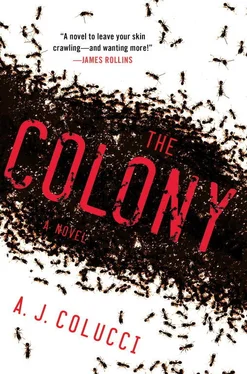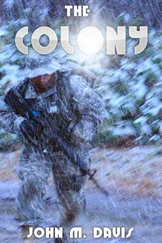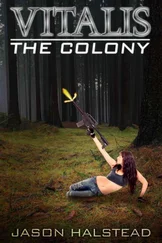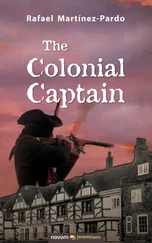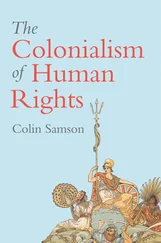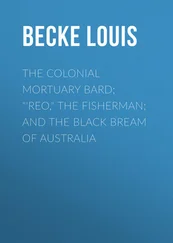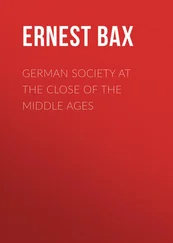A new creature burst onscreen. It had no eyes, just enormous sharp pincers snapping at the camera like an alien in battle. Kendra blinked hard and the word “Siafu” soundlessly left her lips.
“Thank you, Ms. Hart,” Paul said, and once again took center stage. “In contrast, the deadly Siafu of Africa is a vicious man-eater and the only insect known to attack people for the purpose of food. Siafu, also known as driver ants, sweep the forest floor in colonies of twenty-two million. They typically attack their prey en masse by entering the nose and mouth and asphyxiating them. Siafu are blind and react to movement and carbon dioxide; if anything stirs or breathes, they kill it and eat it.” Paul returned to the table. “That’s a brief overview of two of the most deadly insects on the planet. Kendra, if you want to add anything…”
She answered with a cold stare.
“So what’s with the bug lesson, John?” Pat asked the mayor.
Paul replied, “The insects attacking New Yorkers have characteristics of both species, fire ant and Siafu.”
“How’s that?”
“I’ll let our guest explain,” Russo said. “Some of you have met General Leonard Dawson.” Russo motioned to a domineering-looking figure beside him. “The general is actually quite familiar with these insects and he has come here today with some vital information.”
The two-star general sat a head taller than the rest of the group. He had a frame as wide as a doorway; a powerhouse in full uniform. He took command of the table with a booming voice. “Two years ago, the United States military was tipped off about a secluded laboratory in Bolivia. We sent in a surveillance team, which located a sprawling compound—over ninety thousand square feet—camouflaged inside the Amazon jungle. Naturally, we believed it to be a drug operation and immediately organized a raid with the Bolivian government. However, the incursion was a disaster. There was a shootout. A fire erupted, causing major explosions.”
The general turned to Agent Cameron. “That’s when the FBI showed up. Turned out they had been investigating the lab for several months.”
Agent Cameron said, “We had been following a money trail, millions of dollars from an unidentified source in the United States. Our information pointed not to drugs but to ecoterrorists. A scientist working at that lab, Dr. Phillip Laredo, had strong ties to radical environmental groups. As specialists in ecoterrorism, my team was assigned to the case.” Cameron’s jaw clenched. “Until the military got wind of the operation and swooped right in.”
The general cleared his throat in annoyance. “It was not a successful mission, that’s true. Everyone inside the lab was killed. Except for the ants. Millions of them, living in a tank the size of an Olympic swimming pool. The Bolivian government wanted the insects destroyed, the whole place burned to the ground. So the army complied. We gassed the ants in the tank and firebombed the compound. Some of the specimens were collected and brought back to the United States. That’s when we discovered something disturbing—outside of the tank, these ants are indestructible. I can tell you without a doubt, the ants we collected are the same species we’re facing here in New York.”
Paul looked flabbergasted, as if this was all news to him, crucial information he should have been given before anyone else. He said to the colonel, “You gassed the ants?”
“They can be killed in a tank,” Dawson replied. “Certainly not in a city.”
“So you’ve been studying the specimens for two years?”
“We analyzed them for several months. But they died off rather quickly.”
“Surely you learned something about them.”
The general motioned to a uniformed officer by his side. “This is Colonel Tom Garrett. He was working with the team of army scientists studying the specimens and following up on leads with the FBI. Anything we learned in two years, he can share with you.”
Garrett was a tall man in his sixties, with a pasty complexion and dour expression. His salt-and-pepper hair was stiffly sprayed. Despite his chicken-like neck, the cut of his uniform hinted at an athletic frame. He glanced around the table and his gaze lingered on Kendra for just a moment.
“I’ll tell you what I know,” he began. “We believe the project was going on since the 1980s, funded by a group known as Earth Avengers, an extraordinarily sophisticated and clandestine sect of ecoterrorists. These people had access to an unprecedented amount of money, resources and highly trained entomologists. From what the FBI uncovered, it seems their goal was to create man’s ultimate natural enemy. One which could fight back against human destruction of the planet. The insect they created was a genetic mutation of the Siafu and fire ant, which they named Siafu Moto, Swahili for ‘driver ant-fire.’ The result of their work was the most deadly, indestructible creature on earth. The ants live underground and have a lethal sting. They multiply by the millions. They feed at night and will attack anything that moves. Their diet consists of rats and human flesh.”
“Just rats and people?” Pat Dempsey asked, amused.
“We believe they were developed to be an urban weapon,” General Dawson replied. “Kill off people and leave most other creatures alone.”
“New York’s a long crawl from Bolivia,” Pat said. “How did they get under our city?”
“It was Dr. Laredo, the project leader. We believe he escaped the fire and took off with a Siafu Moto queen.”
Cameron added, “The FBI has been tracking him since the raid. We found nothing until a month ago. A photo of a dead man resembling Laredo was taken by NYPD just days after the fire in Bolivia. He was found in Riverside Park. Shot himself in the head.”
Kendra grimaced.
Garrett said, “If Laredo released that queen before killing himself, it’s possible she has produced millions of ants, as well as her clones, which would have started their own colonies all over the city. There may be a trillion ants under Manhattan.”
“That’s insane,” said Pat.
“Maybe,” Garrett replied. “Maybe not.”
Paul spoke with a renewed sense of hope. “We’ll need every speck of research you recovered from the lab. All the genetic modifications, the tests and findings.”
“Didn’t you hear the general?” Garrett said. “The facility was destroyed. All the scientists are dead. I can’t give you anything.”
“You didn’t collect any documents?” Paul said tersely. “I find that hard to believe.”
“Like he said,” the general cut in, “there are no records. Aside from the president of the United States and the faces you see in this room, there are less than fifty individuals in the world who even know about these ants. Let me make this clear; any information regarding the Siafu Moto is proprietary to the United States military. As a matter of national security, there will be no communication beyond this bunker.” He glanced around the table. “You cannot speak to anyone about this. Not your families and certainly not the media.”
His words were met with nervous stares among the group, except for the White House representatives, who sat rigid.
Then the general turned almost apologetic. “Of course, the United States Army takes full responsibility for this disaster. Both the raid and destruction of the facility were tactical errors.”
Colonel Garrett showed no remorse. “The problem will be contained. There is no doubt about that.”
“A trillion ants. I still don’t believe it,” insisted Pat. “What, are they invisible? We’ve had just a handful of attacks.”
Kendra was pondering the same question. “He’s right. And there would be other signs as well. Fire ants create enormous tunnels. A large colony can loosen soil to the point of road collapse. They’re attracted to electrical fields, constantly causing power outages and cable damage. In Texas, ants are the leading cause of traffic light failures. A trillion could black out this city.”
Читать дальше
